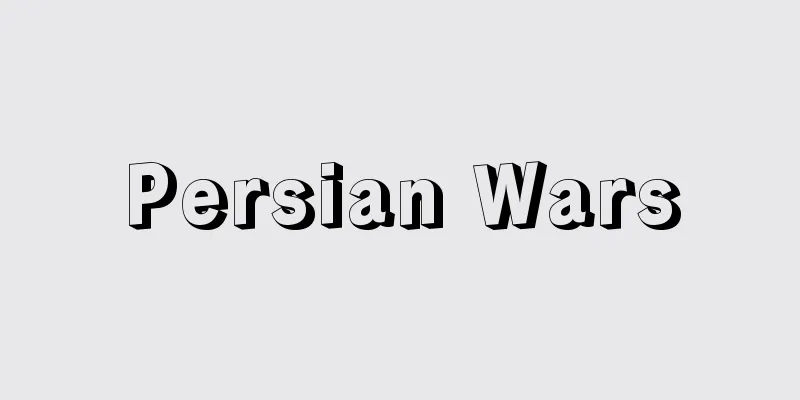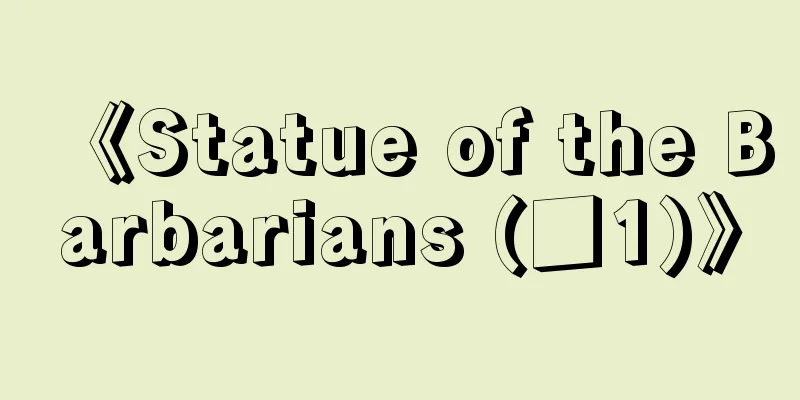Persian Wars

|
A war fought in the first half of the 5th century BC between the Persian Empire and the Greek cities of Athens and Sparta. [Sadao Ito] The Ionian RevoltThe battle began with the Ionian Revolt, an uprising by Greek cities in the Ionian region on the west coast of Asia Minor against Persian rule. In 500 BC, Aristagoras, the tyrant of Miletus, stepped down from his position and called on other Ionian cities to abolish the tyranny that was being used by the Persians as a means of control at the time. This appeal was widely accepted by citizens who wanted to rid themselves of Persian rule, and anti-tyranny and anti-Persian movements arose in each city. These Ionian cities formed an alliance and called for reinforcements from mainland Greece to fight against Persia, attacking Sardis, Byzantium, and Cyprus with success, but the Persian army eventually counterattacked, winning a naval battle off the coast of Lade in 494 BC and capturing Miletus, deciding the outcome. The Ionian cities were again subject to Persian rule, but tyranny was not restored. [Sadao Ito] Darius I's Campaign (First Campaign of the Persian Wars)After suppressing the rebellion, Persia turned its attention to Athens on the Greek mainland, which sent 20 ships to Ionia, and Eretria on the island of Euboea, respectively. After invading Thrace by sea in 492 BC, Darius I sent a large army to Greece in 490 BC in retaliation. After conquering Eretria, the Persian army attacked Athens and landed on the plain of Marathon on the northeast coast, but the Athenian army of about 10,000 defeated them following Miltiades' strategy, preventing the Persian occupation of Athens (Battle of Marathon). [Sadao Ito] Xerxes I's Campaign (Second Persian War)After the failure of the expedition, Persia reorganized its military under Darius' son Xerxes I, and in 480 BC, the king himself led an army far larger than the first expedition, once again heading for the Greek mainland. With the exception of a few cities, the Greek side consolidated its unity around Sparta and Athens, and established a naval and land defense line connecting Cape Artemisium at the northern tip of Euboea Island and Thermopylae Pass at the northern tip of Central Greece, but both bases were defeated after fierce fighting (Battle of Artemisium, Battle of Thermopylae), and the Persian land army invaded Athens. In the face of this crisis, the wise Athenian general Themistocles proposed a plan at a military council of the allied forces to lure the Persian navy into the straits on the east side of Salamis Island, west of Athens, and challenge them to a decisive battle. This plan was approved, and Xerxes's large fleet was destroyed in front of his eyes as he watched from his throne on land, thus thwarting Persia's ambition to conquer Greece (Battle of Salamis). Part of the Persian land army remained in northern Greece under the command of General Mardonius, but they were also defeated by the Greek coalition at Plataea in central Greece in 479 BC and were forced to retreat (Battle of Plataea). Around the same time, the Greek army landed at Cape Mycale in Ionia and won a major victory, paving the way for Ionian independence (Battle of Cape Mycale). After this, the main battlefield of the battle between the Persian army and the Greek coalition continued to move eastward. [Sadao Ito] Until the endIn 478 BC, the Greek army helped the rebellions of the Cypriot cities and attacked Byzantium, succeeding in liberating them from Persian rule. Even after the formation of the Delian League in 477/8 BC, the Greek offensive continued, and in 467 BC, under the command of the Athenian general Cimon, they defeated the Persian army at the mouth of the Eurymedon River on the southern coast of Asia Minor, and in 459 BC, they sent troops to help the rebellion in Egypt. However, the Egyptian expeditionary force suffered a major defeat in 454 BC, and was forced to abandon it in 450 BC after a Persian counterattack in Cyprus. Cimon's death in this battle created a momentum for peace in Athens, and a formal peace treaty was concluded between Greece and Persia in 449/450 BC (the Peace of Callias), thus ending the half-century-long Persian Wars. The Ionian cities were granted independence and managed to escape Persian rule until the end of the Peloponnesian War. [Sadao Ito] significanceThe Persian Wars were fought between the great Eastern power Persia and a coalition of small Western Greek states, and are famous for the fact that Greece, which was far inferior in military strength, won a great victory on land and sea that shines in the history of world warfare. From the Greek perspective, this victory meant that the citizens of each city had protected the freedom and equality they enjoyed against a large army of a different ethnic group consisting of a single despotic king and his subjects. Athens and other Greek cities had almost established democracy at that time, and the citizens were filled with a strong will to protect their own country. This is considered to be the ultimate reason for the success of Greece's defense, but the victory also gave rise to an awareness among the Greeks of a world made up of free citizens, in contrast to the despotic kingdoms of the East, and became an important springboard for the remarkable development of politics and culture in Greece thereafter. [Sadao Ito] "Herodotus, The Histories, translated by Matsudaira Chiaki (Complete Collection of World Classical Literature 10, 1967, Chikuma Shobo)" ▽ "Herodotus, The Histories, translated by Matsudaira Chiaki (Iwanami Bunko)" [References] | | | | | | | | | | | | |©Shogakukan "> Map of the Persian Wars Source: Shogakukan Encyclopedia Nipponica About Encyclopedia Nipponica Information | Legend |
|
紀元前5世紀前半にペルシア帝国とアテネ、スパルタを中心とするギリシア諸都市との間で行われた戦争。 [伊藤貞夫] イオニア反乱戦いの発端は、小アジア西岸イオニア地方のギリシア諸市がペルシアの支配に対して蜂起(ほうき)した、いわゆる「イオニア反乱」にある。前500年、ミレトスの僭主(せんしゅ)アリスタゴラスは、自らその地位を退くとともに、他のイオニア諸市にも、当時ペルシアにより支配の手段として利用されていた僭主政を廃止するよう働きかけた。この呼びかけは、ペルシアの支配をはねのけようとする市民たちに広く受け入れられて、各市に反僭主・反ペルシアの運動が起こった。これらイオニア諸市は同盟を結び、ギリシア本土に来援を求めてペルシアと戦い、サルディス、ビザンティオン、キプロスを攻めて成果をあげたが、ペルシア軍はやがて反攻に転じ、前494年、ラデ島沖の海戦で勝利を収め、ミレトスを占領して大勢を決した。イオニア諸市はふたたびペルシアの支配に服することとなるが、僭主政は復活されなかった。 [伊藤貞夫] ダリウス1世の遠征(ペルシア戦争第1回遠征)反乱鎮圧後、ペルシアの目は、それぞれ20隻、5隻の艦船をイオニアに送ったギリシア本土のアテネ、エウボイア島のエレトリアの両市に注がれた。前492年に海路トラキア遠征を行ったのち、前490年、報復のためダリウス1世は大軍をギリシアに派遣した。ペルシア軍はエレトリアを制したのち、アテネを襲って北東岸のマラトン平野に上陸したが、約1万のアテネ軍はミルティアデスの作戦に従ってこれを破り、ペルシアのアテネ占領を阻んだ(マラトンの戦い)。 [伊藤貞夫] クセルクセス1世の遠征(ペルシア戦争第2回遠征)遠征に失敗したペルシアは、その後ダリウスの子クセルクセス1世の下で軍備を整え、前480年、第一次遠征軍をはるかに上回る大軍を王自らが率いて、ふたたびギリシア本土を目ざした。ギリシア側は、一部の都市を除き、スパルタとアテネを中心に結束を固め、エウボイア島の北端アルテミシオン岬と中部ギリシア北端のテルモピレー峠とを結ぶ線を海陸の防衛線と定めたが、二つの拠点はともに激戦のすえに破られ(アルテミシオンの海戦、テルモピレーの戦い)、ペルシア陸上軍はアテネに侵入する。この危機に際し、アテネの知将テミストクレスは、アテネ西方サラミス島東側の海峡にペルシア海軍を引き寄せて決戦を挑む策を連合軍の軍議で主張して、それを通し、陸上の玉座から観戦するクセルクセスの目の前でその大艦隊を壊滅させ、ペルシアのギリシア制圧の野望をくじいた(サラミスの海戦)。ペルシア陸上軍の一部は将軍マルドニオス指揮の下にギリシア北部にとどまったが、これも前479年、中部ギリシアのプラタイアイでギリシア連合軍に敗れ、撤退を余儀なくされた(プラタイアイの戦い)。同じころイオニアのミカレ岬でも、上陸したギリシア軍が大勝して、イオニア独立への道を開いた(ミカレ岬の戦い)。こののちペルシア軍とギリシア連合軍との戦いは、主戦場を東方に移して続行される。 [伊藤貞夫] 終結まで前478年ギリシア軍はキプロス島の諸都市の反乱を助け、ビザンティオンを攻めて、いずれもペルシア支配からの解放に成功する。前477/8年デロス同盟成立後もギリシア側の攻勢は変わらず、前467年アテネの将軍キモンの指揮の下に、小アジア南岸エウリメドン河口でペルシア軍を破り、前459年にはエジプトでの反乱を助けるべく兵を送っている。しかしエジプト遠征軍は前454年に大敗を喫し、キプロスでもペルシア側の反攻にあって、前450年これを放棄するのやむなきに至った。この戦いでキモンが死亡したことは、アテネに和平の機運を生じさせ、前449/前450年ギリシアとペルシアとの間に正式に和議が結ばれて(カリアスの和約)、ここに半世紀にわたるペルシア戦争は終結した。イオニア諸市は独立を認められ、ペロポネソス戦争末期に至るまでペルシアの支配から逃れえた。 [伊藤貞夫] 意義ペルシア戦争は、東方の大国ペルシアと西方ギリシアの小国家の連合とが戦い、兵力において格段に劣るギリシアが世界の戦史に輝く大勝を陸上、海上を問わずに博したことで名高い。この勝利をギリシア側からみれば、各ポリスの市民たちが、自ら享受していた自由と平等を、1人の専制王と彼に服属する臣民とからなる異民族の大軍に対して守り通したことを意味した。アテネをはじめギリシア諸市は、当時、民主政をほぼ確立し、市民たちの間には自らの国家を守る気概が満ちわたっていた。そのことがギリシア防衛を成功させた究極の原因とみられるが、このときの勝利はまた、東方の専制王国とは対照的な、自由な市民たちからなる世界についての自覚をギリシア人の間に芽生えさせ、以後のギリシアにおける政治と文化の著しい発展の重要なばねとなった。 [伊藤貞夫] 『ヘロドトス著、松平千秋訳『歴史』(『世界古典文学全集10』1967・筑摩書房)』▽『ヘロドトス著、松平千秋訳『歴史』上中下(岩波文庫)』 [参照項目] | | | | | | | | | | | | |©Shogakukan"> ペルシア戦争の経過図 出典 小学館 日本大百科全書(ニッポニカ)日本大百科全書(ニッポニカ)について 情報 | 凡例 |
<<: Persian Empire - Pershiateikoku (English spelling) Persia
>>: Persian Letters (English: Lettres persanes) French
Recommend
Colette, Sidonie-Gabrielle
Born January 28, 1873 in Saint-Sauveur-Ampuizay, B...
Nueva Caceres (English spelling)
...Population: 103,000 (1994). Founded in 1573, i...
Orchestra Rehearsal
... Fellini, who was hailed as the ``new genius&#...
Public assistance - Seikatsuhogo (English spelling)
Based on the principles of Article 25 of the Japa...
Jingyoryo - Jingyoryo
This refers to the section of the Ritsuryo Code th...
gamaka
…However, a scale can be recognized even if the a...
Fisheries research and guidance vessel - Gyogyouchousashidosen
…No new whaling ships have been built in recent y...
Ust'-Ilimsk (English spelling)
...Large timber production is expected in the are...
Easter Monday
...In addition, there is a custom of eating eggs ...
Invincible (aircraft carrier)
After World War II, no country could possess a mo...
Temporary New Year - Kasakushogatsu
…When bad weather threatened the autumn harvest, ...
Famous Places Paintings
In the Heian and Kamakura periods, it was one of t...
Mount Hoshu [Village] - Hoshuyama
A village in Asakura County, in the central-easter...
Sinker - Ashina
…Generally, each one is small and many of them ar...
Kaiser mustache - Kaiser mustache
〘 noun 〙 (from the beard of German Emperor Wilhelm...









